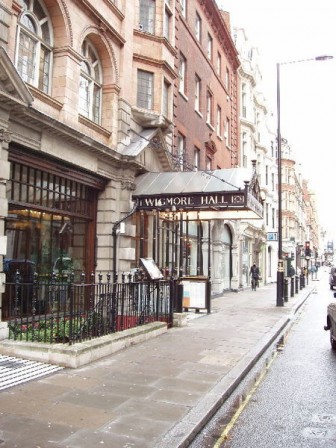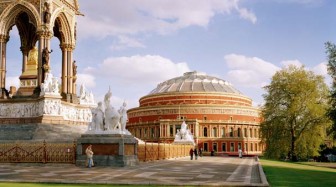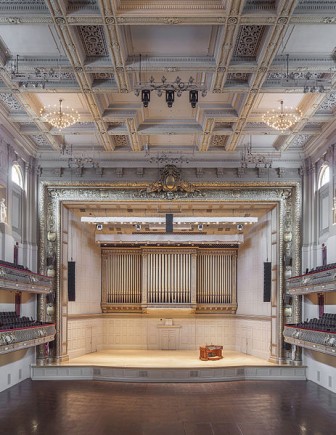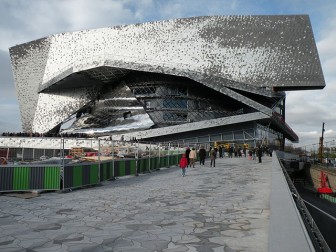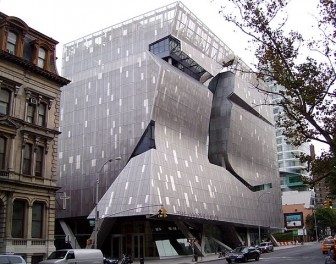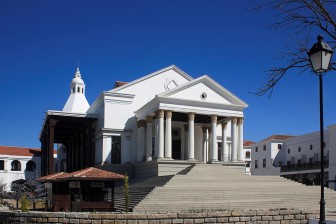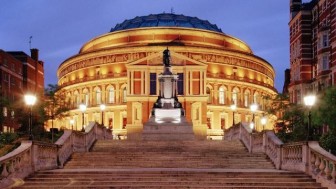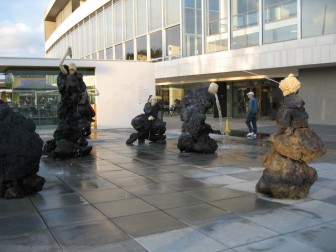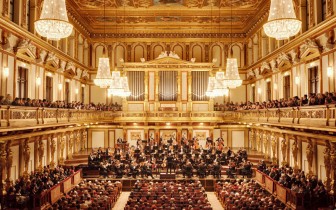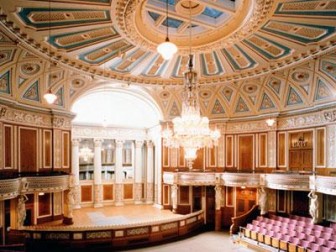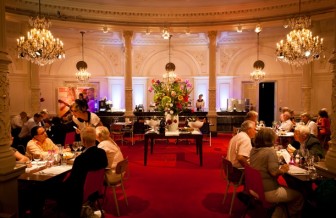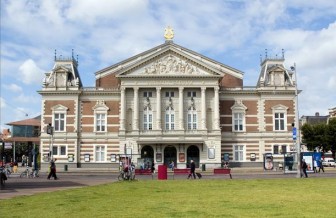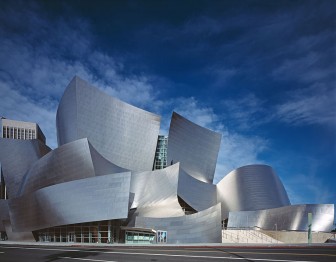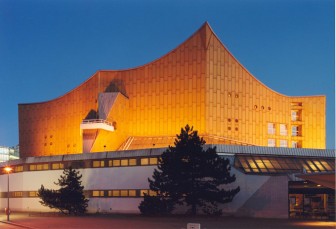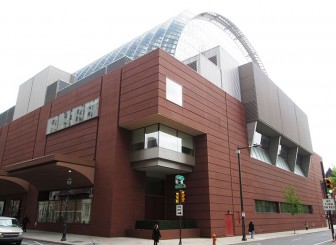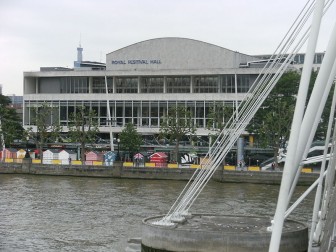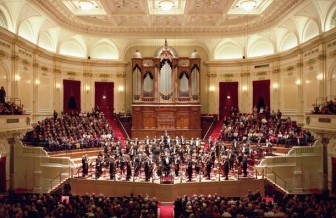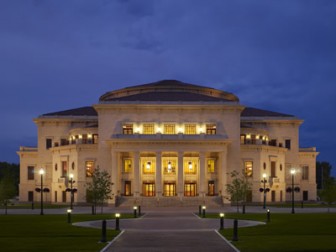EDITOR’S NOTE: This essay is reprinted here with kind permission of the author. It first appeared on his website, where the reader will find much more of interest.
In the last century, very often the concept of “progress” was projected upon the arts as a measurement of quality: “good art” was “progressive art.” If an artist did not commit some “groundbreaking” artistic deed, his work was considered worthless. While progress in science is a fundamental notion, in the arts it is meaningless because the nature of art has nothing to do with progress. There may be progress in terms of physical means – like the types of pigment used in paint, which became more stable in the last century, or the relatively cheap paper for musical notation that became available with the advent of the 19th century’s Industrial Revolution, or the iron fittings in architecture that allowed builders to vault bigger spaces. The discovery of perspective by Bruneleschi in the 15th century was also something like progress, as was the “sfumato” brushwork developed by Leonardo da Vinci, which gave painters the means to create a hazy atmosphere on the canvas. But expression, artistic vision, the quality of execution has never been dependent upon the physical means of an art form: Vermeer has not been superseded in terms of artistic quality by Picasso or Pollock, Bach not by Mahler or Boulez, Michelangelo not by Giacometti or Moore, Palladio not by Gropius or Le Corbusier. And we can appreciate the brilliance of the “primitive” masters of Flanders, who lived before the great surge of 16th-century inventions in Italian painting, just as we can the music of Palestrina, who had no clue of Bach, Mozart, Beethoven or Chopin simply because he lived in an earlier time.
Because it addresses itself to our most sensitive aesthetic receptivity, the successful work of art – the one that achieves artistic greatness – lifts itself from its physical “body” and becomes “timeless.” Because it addresses universal capacities of the human mind and heart, it “speaks” to us over distances of time and place. Great art is aspirational: it represents the best of the human species and it stimulates the development of our inner experience of and reflection upon life. Great art is a symbol for, a mirror of, and a stimulus to the human condition. Of course not all art aspires to that height, but the best works offer something of a focus point, an ideal, and an instrument of quality assessment. Gifted artists attempt to emulate the great works of both contemporaries and the masters of the past and they try by hard work to get the best out of their talents. The serious and gifted artist will not look at ephemeral fashions, but will try to get at the heart of his art form and will look for the best instruments available to realize his vision. It will be clear that all this has nothing to do with the intention to be “progressive” or “modern.” The artist is already and always necessarily contemporary, whatever he tries to do. Artists who try to be “progressive” or “modern” – i.e., who try to be consciously and intentionally “of their time” – betray their superficiality and lack of substance, and they betray their artistic efforts as attempts to cover-up an empty space.
In the same way, serious artists do not try to be “conservative” as a conscious attempt to affiliate themselves with groups or movements in the art world for opportunistic reasons. J.S. Bach was considered “conservative” in his own time. Other composers at the time were exploring very different paths after they came to consider the “strict” Baroque style to be outdated. But Bach, about whom there is no evidence that he considered himself to be a conscious “conservative,” created new music based upon that style, and he found many new ways of combining things, filtering them through his own superb musical personality and thereby giving them a fullness of life which, with hindsight, looks like a last overwhelming sigh of the Baroque period in which all strands that made up its language found an apotheosis. (Of course, at the time the term “Baroque” as applied to music did not exist; we use it here for convenience’s sake.) In comparison with his contemporaries, Bach found the possibilities he discovered in older styles much more interesting than the new, fashionable and more naive way of composing – and rightly so. How could he have known the miraculous synthesis a Mozart or a Beethoven would one day create? Their precursors – Bach’s contemporaries – were interesting, but what they were doing was far and away less interesting than what Bach was doing or what Mozart, Haydn, and Beethoven were going to do.
While the concepts of “progressive” and “conservative” have thus no meaning in the arts, it is nonetheless true that the art forms developed and were in constant flux, under the influence of many diverse artistic personalities, circumstances, social contexts, and the like. The current situation in both the visual arts and in (serious) music is not the result of a linear, “progressive” development in the various art forms, but of the flow of a broad delta that spread its many streams since the stream banks of traditional art gradually lost their more or less stable form after the demise of the Ancien Régime. The liberation of the bourgeoisie brought with it the liberation of the artists. Patronage was gradually replaced by the market, and in the enthusiasm of free exploration – often against the constraints of bourgeois tastes – the arts found their stasis after World War II in the various forms of modernism. Concept art and concept music (atonal music: sonic art) became the established forms of “new art” in the Western world – in Europe supported by the state and the educational institutions, while in America private funding took on the role of Maecenas. And in the 20th century, it has been the myth of “progress” which has propelled these developments, like a wind blowing the many little streams of the delta upon a barren coast of stone and sand where the sea of oblivion would wash away their products – products which were often merely the wreckage of artistic failure when viewed from the heights of the achievements of the art of the past. Modernism and conceptualism in the arts (including its watered-down progeny) never strove after artistic greatness; this explains the gradual disappearance of greatness from both the visual arts and music.
We can also translate the term “progress” as “innovation.” Artists who seem to invent something that has not been before are often considered “greater” than artists who seem to have been content with available materials and styles. But this is a relatively new phenomenon. In pre-revolutionary times – say the 18th and 17th centuries – there were no discussions about “innovation,” “progress,” “exploration” and the like. They popped-up during the 19th century and got riotous in the 20th. But did those earlier artists not explore and invent? Of course they did, but not intentionally so. Invention and exploration where the result of their artistic efforts, not a conscious goal. They tried to create good art, and if they had something of a personal signature, they automatically transformed the available materials and styles into something personal. That is why we immediately recognize the personal styles of Rembrandt, Vermeer, Rubens, Velasquez, and Caravaggio even though they used the same visual “language.” Innovation had always been a natural part of the artists’ craft. They did not need to turn it into a banner or a marketing device. So great art is always innovative, but not in the way innovation has meaning in science: in art, innovation is personal, temporal, and not part of a movement, of a communal enterprise where the boundaries are explored as part of a common attempt to liberate the arts from dominating restrictions.
The myth of progress and conscious innovation as it raged in the last century had the unfortunate effect of giving teeth to the philistines: people in establishment positions used it to make distinctions in terms of quality which had nothing to do with real artistic quality, resulting in the nonsense of concept art (where an unmade bed almost wins the Turner Prize) and of sonic art (where indigestion noises are dressed-up as music). It also had the effect of reinforcing suspicions about art which still adhered to older notions of artistic value and meaning: they were seen as expressions of an elitist and conservative culture attempting to suppress the tastes of the masses, as remnants of undemocratic and unjust times where hierarchical thinking led to authoritarian, arbitrary violence. To many people, the notion of artistic quality became tainted by associations with totalitarian regimes, crime, and injustice – especially since Nazi Germany and Soviet Russia showed how classical art could be misused as instruments of legitimization by criminal governments.
And here we have arrived at a very sensitive problem and the paradox of the arts today. According to the official establishment, modern art and modern music are supposed to reflect our free, modern age, occupying a different space than those occupied by pre-modern art, which is safely locked-up in museums and in concert halls and opera houses dedicated to classical music. What is considered “classical” art nowadays was hardly ever considered so at the time of its conception. It has become “classical” since modernism became the “official” new art of the 20th century as a way to define the difference between that which was, and that which is – the art of former generations who suffered in a hierarchical society, and the art of today, created by us, we who are liberated and enjoy the luxury of a progressive, egalitarian society where everything is valued by its own intentions and where hierarchical qualitative norms have been banished because they are elitist, oppressive, and so on. And yet, a great majority of people have developed enough artistic sense to understand and appreciate the great art of the past. They flock to the great collections enshrined in grand museums like the Louvre, the National Gallery, and the Uffizi and to concert halls and opera houses to experience the thrilling creations of dead white males from undemocratic ages. This “old art” did not naturally develop into the modern art of today, but forms an altogether different world of sensibilities. The upheavals of two world wars and industrialization, together with fundamental cultural shifts in society, play a crucial role in the appearance of this rift in creative thinking, the roots of which can be found in the 19th century. Eyes and ears educated in the best that any art form has to offer will not fail to see and hear the difference between “old art” and “new art.” This is not “conservatism,” since that does not exist in the arts, but a normal observation supported by experience. And a preponderance of “new art” is, by any standard, simply not good – at least, it fails abysmally in comparison with the best art of former ages.
It is a mistake to see criticism of modern art as a bourgeois defense reaction against modernity, since the bourgeois society which protested against the impressionists and against Debussy and Schönberg no longer exists. If we could not criticize “modern art” in our own day, there would not exist any bad modern art. Without criticism, how could we know it? Therefore, we should feel free to criticize inferiority where we find it, trusting that indeed there are general, objective norms and standards for artistic quality and talent, even if they cannot be precisely formulated. All great art of the past has been created on this assumption, thereby empirically proving the fact. (That these norms change over time does not refute the idea that indeed there are norms.) In the same way, we know that something like “love” does indeed exist, although it is impossible to formulate the phenomenon in such a way as to arrive at an objective, testable description, as in science, and in spite of the different forms in which love manifests itself, in other places, other times, other cultures. We also have an inborn sensitivity to aesthetic quality, which is (to name an example) otherwise expressed in the intentions to create our living areas in such a way that we feel comfortable therein. Beauty – which had always been a natural part of any work of art – is not persé kitsch or Adorno’s “false consciousness” (how could he know?), but an indication of a higher vision of life, and therefore important to what we best call the human condition.
“Old art” and “old music” still “speak” to us, because they have universal qualities that transcend time and place. That is the reason behind the iconic value conferred on the great “old” collections in the museums and on the “old” repertoire fêted in the “traditional” concert halls and opera houses. In fact, this “old art” is not old at all, but contemporary forever because its great qualities can be interpreted again and again by every generation. There is an interaction happening between the living generation and the voices which come to us from the past – a dialogue. And this dialogue is ever new. Concept art and sonic art, whenever attempting to be serious, could create a similar dialogue, but this dialogue would be different in its character because these art forms have different “messages.” Often these messages reflect a negative outlook upon human life, upon contemporary times, and upon human nature. No doubt, these criticisms have a rightful place in our society, but they should not be seen as natural descendents of the art of former times. Concept art and sonic art are something really new – like photography developing alongside painting in the 19th century. To call concept/sonic art the result of progress and thereby implying that it is just the old art but developed towards and into modernity is to deny the newness of these new art forms altogether. Let it be new, but don’t let it be art in the sense of art of former times. The fact that “old art” and “old music” are still of great importance to us keeps them new and presents them as an alternative to what is now establishment-sanctioned modern art and music. Would it not be great if contemporary artists would try to emulate the “old art” and pick up former artistic values and norms to develop them according to their own insights and life experiences (as Bach did)? And indeed, that is already happening and has been now for many years: new figurative painting is enjoying a renaissance, as is new tonal music based upon “traditional” values. These are not conservative movements but fully modern, contemporary art forms that give the lie to the outdated myth of progress and innovation for their own sake. Are these art forms dull, imitative, derivative, nostalgic recollections of times which have long past? By no means. In contrary, compared to the modern art and modern music of the establishment they are a breath of fresh air, since they explore techniques, values and aesthetics which – as we have seen – are not restricted to time and place and are thus universally valid and renewable.
There is a good reason why a Jackson Pollock or an Andy Warhol is not hung next to a Velasquez or a Manet or (even) a Dali, why there are museums exclusively dedicated to modern art, and why there are “modern music festivals” and specialized ensembles and concert venues exclusively dedicated to “modern music,” which is mostly sonic art or derivations from pop or “world music.” They form a different field of sensibilities and aesthetic values which would rightly be experienced as an intrusion from outside within the context of “old” art and music. But new figurative art mixes very well with the “old” collections, just as new classical music fits very well into a regular, classical music programme in a classical concert hall. There is a continuum that embraces “old” figurative art/tonal music and new figurative art/tonal music. The element that unites all the different forms of these arts is mimesis, the old Greek concept of art as representing and interpreting reality as man experiences it – including the stirrings of his inner life – and which is realized by means that make use of the forms of perceived reality, in the case of visual art, and by means that metaphorically reflect emotional experiences, in the case of music. (Mimesis was first formulated by Aristotle.) But while the visual arts include elements of visual reality, great art never merely imitates it (as the many religious works amply attest). In music, the flow of lines and the changes in harmony reflect the movements of the emotions, while never merely imitating them (which would result in directionless utterances). In both the visual arts and in music, human experience is stylized in an aesthetic, imagined space, which gives these experiences a meaning and quality on a higher level than what we experience “in the raw.” This explains the stimulating effect of great art: it transcends the earthly level of our life, transporting it to a higher realm, and thus ennobles it – even where the experiences as such are not pleasant at all (like the numerous crucifixions in religious art, which can be considered fairly regular human experiences symbolically re-enacted in mythological form). This quality of transcendence can rarely be found in the establishment’s “modern art” and “modern music.” They have very different aims.
New mimetic art explores meaning, value, and beauty as universal qualities of the human condition. It exists next to modernism in all its forms – not in opposition, but as a fruitful alternative after more than half a century’s celebration of the negation of universal values. What is progress? In culture, and especially in high culture, progress is the attempt to make something better, which implies hierarchical thinking: if there is something better, this means that there is also something worse. During the Italian Renaissance, artists strove to make things better, to paint better, to build better, to compose better (read Giorgio Vasari’s The Lives of the Artists). In their time, they were modern as a result of their intention to be better, and not the other way around. And they chose as a measurement of quality the art of antiquity: a thing of the past. Eventually, in their intoxicating self-confidence, they tried to surpass the art of antiquity – which shows their freedom in interpreting their examples. At the end of the 17th century, a discussion ensued in France – then at the forefront of contemporary, modern, backwards looking art – about whether “the moderns” were better than the “old” or not – the “querelle des anciens et des moderns.” This would have been unthinkable in the 20th century, when being “better” was, under the delusion of the myth of historical progress, considered the result of being “modern.”
Of course Vasari was wrong to think that art of ages immediately preceding his own was “less good” than the works of his contemporaries: Mantegna is not superseded, in artistic terms, by Leonardo or Raphael. It was the means that became available to artists, which got better, not the qualities of artistic vision. The point is that developments on the material level are something different from the psychological/aesthetic level of art. What a work of art “says” is something different from the materials in which it is “said.” If “progress” is used in reference to the material level, more possibilities become available to the artist; if the term is projected upon the artistic vision itself (the psychological and aesthetic level), and on top of that is imposed a linear, historical perspective, as happened in the 20th century, artistic possibilities will eventually diminish. And that is what we have seen in the last 50 years. The obligation to be “modern” closes off the arsenal of means that developed in the past, the result being that the range of possibilities becomes ever narrower. And in the end, all available material means seem to be “exhausted,” since the artist looks upon the material level as the most important one.
The modernist composer György Ligeti said in an interview that he felt imprisoned between, on one hand, the past, and on the other, modernism – the avant-garde which he himself had helped into being but which he felt he had somehow to transcend, because “progress” meant to him having to “go forward” all the time on the line of historical development. For Ligeti, modernism had become petrified into a mentality which had to be “overcome,” had to be “surpassed” along the line from past to future – but in which direction? The artists of the Renaissance (and of later times during the ancien régime) never got into such dead-end street because learning from examples and freely delving into the material means of the past protected them from a historical, linear perspective. They tried to create good art and, if possible, to emulate or surpass the works of other artists, be they in the past or in the present. While trying to create good art, the past was always there to be of help and support. They never felt “threatened” by the art of the past because their awareness of being “modern” was not in opposition to it. This freedom of thought made infinite exploration and variation possible.
From 1648 till 1665, Amsterdam built its new, “modern” town hall. It had to express the power, wealth, and importance of the capital of the United Provinces of the Netherlands at the climax of what later generations called the “Golden Age” of Holland. Amsterdam was built of small, individual houses in the traditional gable style in brown brick and/or wood along small streets and a network of canals (which would be extended over the years). But this new, central building had to be different and as modern as possible – underlining the present as something of a higher order than the past during which the town had developed – because Amsterdam’s glory was a thing of the present, not of the past. The style chosen was Italian classicism, which was seen as the most up-to-date and modern style because it was considered to be “the best,” forming a stark contrast to the other, older architecture of the town. So the new town hall was supposed to be “better” than the recent past and the way to achieve this was to hark back to an older past, as was then the contemporary way of thinking: people could explore the past as a treasure trove of possibilities and choose what they thought of as “the best.” In Amsterdam of the 17th century, “the best” was represented by an architectural style which recreated the grandeur and spaciousness, and the rich ornamentation, of Roman antiquity; the classicist Italian Renaissance tradition fulfilled that requirement in an excellent way, according to the city council and the architect, Jacob van Campen. (It must have been a very expensive undertaking, since the lightish natural stone and the sparkling marble had to be imported from abroad, Holland being a country of clay and sand.) Following the same line of thought in which past and present share a continuum from which art can be freely chosen, the dome of Rome’s Saint Peter was modeled upon the Pantheon, the famous circular temple of Roman antiquity. The building of Saint Peter was by far the most spectacular building adventure of the 16th century, and again, the most “modern” in the old sense. The invention of the opera – a totally new idea at the time – was born from the attempt to recreate the plays of Greek antiquity. These rather random examples reflect a very different interpretation of the concept of modernity than has been the custom during the last century – and an interpretation of the world which did not see a conflict between past and present. In the place of our myth of progress and modernity was their myth of a golden age, by which the past stimulated new creation. It was idealistic nostalgia which spurred artistic developments, with innovation as a result of a universal vision of the arts as a timeless continuum where works of art from the past interact with art of the present, and in which examples stimulated emulation and thus created an endless progeny of great works. This continuum is best described as “classical” – not in the sense of “old” and “bygone,” but in the sense that it indicates an understanding of continuity with the past. It does not hamper new innovation and personal interpretation, but rather stimulates personal creation under the influence of examples which provide standards of excellence. In this sense, new classical art is a continuation of the great tradition of European art of the past, a living process of continuous renewal and interpretation, without the delusions of progress and modernity as a goal to strive after consciously.
To what extent is new classical art, because of its focus on examples, derivative? What do we mean by the term derivative? If we mean thereby an art which is a mere imitation of what has already been “said,” the term can be applied to any art, of any time and place. But even “derivativeness” should not be considered a merely negative quality, as the art of old Egypt amply shows, where repetition was de rigueur. Individual freedom of the artist, as developed in Europe over the ages, is a great good. It created the possibility of multiple variations. But individuality which becomes so personal that it has no meaning for other people results in the void of pointlessness. Art needs a continuum of works of art which refer to each other to create a framework of meaning, value, and norms against which personal originality can stand out. New classical art is an attempt to restore something of this framework, which existed before the emergence of modernism, and which now – in the 21st century – offers the best hope for the renewal of the arts. New classical artists, both in the visual arts and in music, do not imitate, but apply mimetic “languages” to express individual experience, and this experience is inevitably contemporary. That these “languages” freely take their means from traditional mimetic art forms is perfectly natural, just as Renaissance artists looked towards antiquity to develop their skills and personal styles.
Classicism, thus interpreted, may become the landmark of artistic innovation in our own time: interpretation of the past as a contemporary exploration, and a liberation from the restricting myth of modernity in the arts which has created so much confusion and havoc in the last century.









